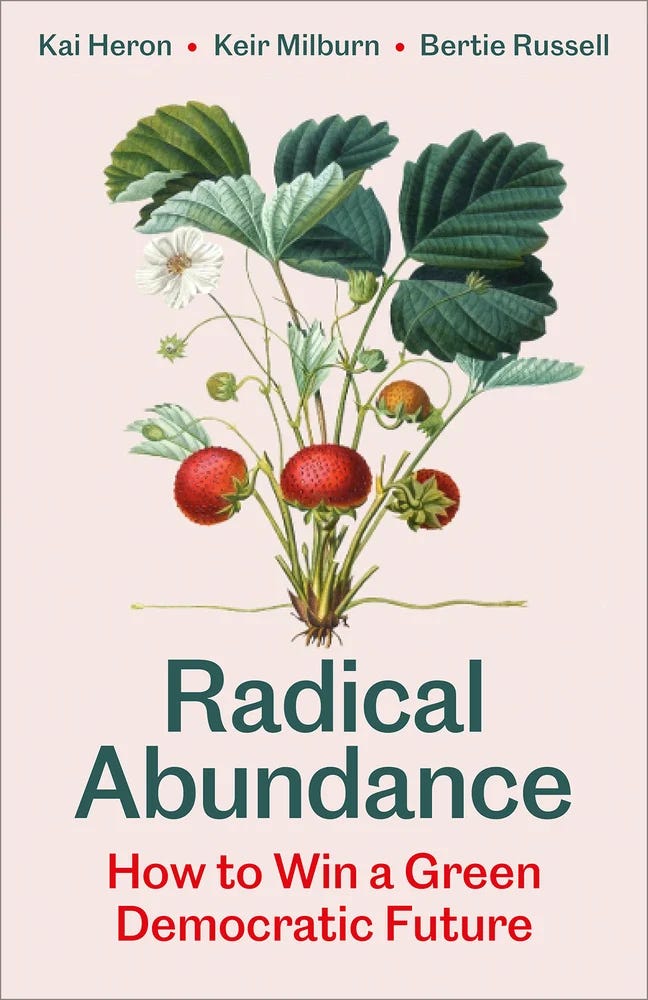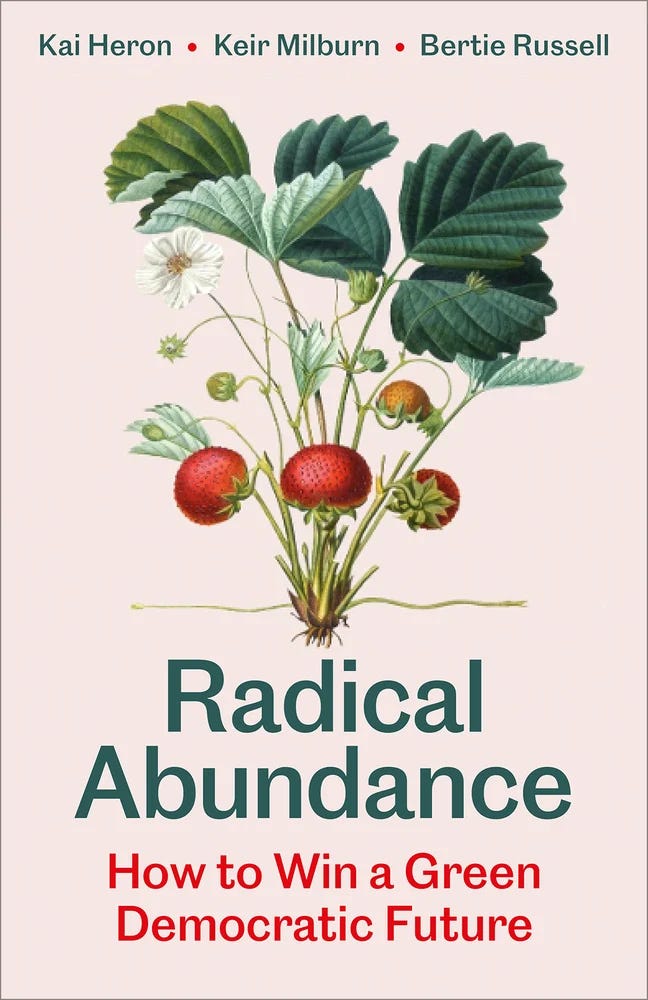Actual Abundance and How to Get There
A review of Radical Abundance from Pluto Press

A quick note before the article: Brief Ecology produces something increasingly rare in the media landscape: independent journalism that is not beholden to the interests of billionaires. Being fully reader funded means Brief Ecology only publishes pieces that inform and educate for the good of society. Thanks for reading.
Actual Abundance and How to Get There
A review of Radical Abundance from Pluto Press
What would a path to abundance for all actually look like? That is the focus of the new book, Radical Abundance, from Pluto Press. The title is a reference to the much-maligned book, Abundance, by Ezra Klein and Derek Thompson, and the authors of Radical Abundance (Kai Heron, Keir Milburn, and Bertie Russell) present a radical, anti-capitalist, and democratic alternative to the neoliberal vision offered by Klein and Thompson.
One of the core arguments made throughout Radical Abundance is that capitalism cannot deliver abundance for all. Here it’s worth unpacking what the authors mean by abundance. Capitalism produces what they call “bullshit abundance”: pollution, soil degradation, deforestation, unhealthy food, microplastics, contaminated water, stress and anxiety, pointless jobs. These things are all abundant in global capitalism. Simultaneously, the things we actually need and want-free time, clean air and water, nutritious food, meaningful work-are scarce, and this scarcity is artificially maintained in order to support profits.
More capitalism, as Klein and Thompson suggest, can only provide more bullshit abundance. The authors of Radical Abundance argue that this is due to capital’s control over economic production. The dynamic of artificial scarcity and bullshit abundance is actually required for the capitalist economy to function. A post-capitalist world is one where the things that society needs are available to everyone. These aren’t new ideas, but what is new about Radical Abundance is a much-needed model for how such a transition might be structured.
According to the authors, the transition from capitalism to a broadly defined socialism that is no longer under capital’s control is too often overlooked. They put forth two necessary processes that such a transition requires: popular protagonism and contested reproduction. Popular protagonism refers to producing the conditions and institutions that allow for people to democratically participate in forming the structures that govern their lives, which by default develops and reinforces a collective consciousness. Contested reproduction uses these conditions and institutional forms to resist the tendencies of capitalism, paving the way for economic relations that are not based on producing a surplus for profit.

If this all seems too abstract to be of actual use, fear not, because the specific institutional form that Radical Abundance argues for is, in my opinion, an exceptionally well-developed model for transitioning away from capitalism. The authors call this institution the Public-Common Partnership (PCP), and it is perhaps the most realistic alternative to capitalist production that I’ve seen.
So, how does a PCP work? The specifics depend highly on context, but the basic model has three components. The first is the workers. Any economic enterprise has to have workers, and in PCP the workers would have democratic control over the conditions of their labor as well as shared ownership of the PCP as a whole. The second component is a public body. This could be a municipal or other local governing body that also takes a stake in the PCP ownership and governance. The last component is what the authors call a common association. The common association is comprised of members of society who live in a pre-defined geographic proximity to the sites of production. They too have shared ownership and governance over the PCP, which is referred to at this point as the Joint Enterprise.
I don’t have the space here to fully explore the specific characteristics of the Joint Enterprise (JE) that make it so promising (that’s what the book is for, after all), but there are a couple worth mentioning. The first is that as an institution of shared governance (between the workers, public body, and the common association), it functions as both a form of popular protagonism–where members of society develop the skills to democratically govern the economy–and also a form of contested reproduction that resists the exploitative tendencies of capitalism’s profit motive. For example, technological improvements to a manufacturing JE could be put toward requiring workers to put in fewer hours, rather than worker layoffs or unneeded increases to production.
The second is that the structure provides a system of checks and balances on economic production between the three various components. Since the interests of workers, a municipality, and other members of society may often diverge, shared ownership and governance of the JE prevents these entities from exploiting one another while allowing for democratic decision-making on how best to handle whatever surplus may arise.
Radical Abundance looks at three areas of economic production where PCPs could be applied today. The industries the authors identify are urban development, pharmaceuticals, and food systems. In the interest of brevity, I’ll omit a detailed summary of these, but again, the PCP has a high degree of feasibility to function as a realistic and achievable alternative to capitalist institutions in each of these examples.
The value of Radical Abundance is in the authors’ recognition of the complexity of the capitalist economy. This is not a book about mutual aid or worker co-ops. Not that those things aren’t useful forms of organizing, the authors themselves state as much, but they lack the rigor, scalability, and structural development to serve as serious alternatives to capitalist production as it currently exists. The Public-Common Partnership in Radical Abundance is indeed a radical new way of organizing production not for profit, but for the benefit of society. For that reason, I think this text is an immensely important addition to the conversation about how to make society more ecological.



Oh, that sounds like a great read. Some of this reminds me of The Serviceberry by Robin Wall Kimmerer (a book I highly recommend).
Thanks for the rec! This book sounds like it needs to go to the top of my TBR pile.